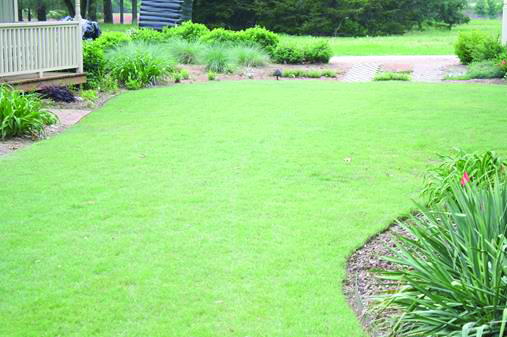Water-Wise Landscape Principles For Oklahoma
Water-Wise Landscapes
Water-wise landscaping (commonly known as xeriscaping) is a landscape practice designed to provide effective water management strategies for outdoor landscapes. These strategies are based in water conservation and the efficient use of water in all aspects of the landscape — from design to maintenance.
Xeriscape is a term applied to low maintenance and efficient landscapes. The term often is misunderstood to mean “zero” or no landscaping. Xeriscapes may look like a traditional landscape, but are established with a set of principles that save water and maintenance time. The term water-wise landscape is used to emphasize the relation to water conservation.
Water-wise landscaping is not the exclusive use of rocks and cactus, or the elimination of turfgrass. Water-wise landscapes are designed to save water and can be creative, and attractive.
Water-wise landscapes may look different, depending on where they are located. Plants appropriate for Oklahoma will differ from those appropriate for Arizona or other places (Figure 1). However, the same principles apply no matter the location.

Figure 1. Buffalograss: A native Oklahoma turfgrass that does well in the state’s climate.
Seven Water-wise Landscape Principles
Plan and Design: The best landscapes start with planning and design. Take time to plan out your landscape and consider shade, drainage and other factors that may impact new landscape features (Figure 2).

Figure 2. Pervious pavers: Consider the installation of pervious hardscapes that allow water to infiltrate rather than run off.
Improve Soil: Start with a soil test (Figure 3). Healthy soil holds more water and provides better growing conditions for plants. Improve soil by adding compost and organic matter.

Figure 3. Soil test bag: Perform a soil test to ensure the soil has the nutrients required to maintain a healthy landscape.
Practical Use of Turf: Turf serves important functions in the landscape, but can require significant amounts of water to maintain. Select turfgrass species well-suited to Oklahoma’s climate, water infrequently and deeply, and implement functional turfgrass species.
Use of Mulch: Mulch covers the soil and retains moisture. A layer of mulch can be a great way to conserve water, limit weeds and reduce the amount of maintenance required.
Efficient Use of Irrigation: Irrigation can be an important tool. However, it is important to implement efficient irrigation technologies to maximize the efficiency of water use.
Select Appropriate Plants: There are many native plant species available that are well-suited to Oklahoma’s climate. It is important to select a plant that is adapted to the local moisture and temperature conditions.
Implement Good Maintenance Practices: Maintenance preserves the beauty of a landscape and contributes to water savings. Practices such as correct mowing height, pruning and weeding all help to save water.
Importance for Oklahoma
Much of Oklahoma receives good average annual rainfall. However, it often doesn’t fall during hot, summer months when plants need it most. Oklahoma’s rainfall is highly variable from year to year and, when coupled with population growth in Oklahoma’s urban areas, can create stress on water supplies.
During hot summer months, as much as 50 percent of all water is used on outdoor landscapes. Oklahoma water-wise landscape practices establish colorful and attractive landscapes that require less water and maintenance than conventional landscaping.
Water-wise landscapes are designed to work with periods of natural rainfall and to be hardy enough to withstand long periods of drought.
Consider implementing the seven water-wise landscape principles in your landscape!
David Hillock
Justin Moss
Joshua Campbell
